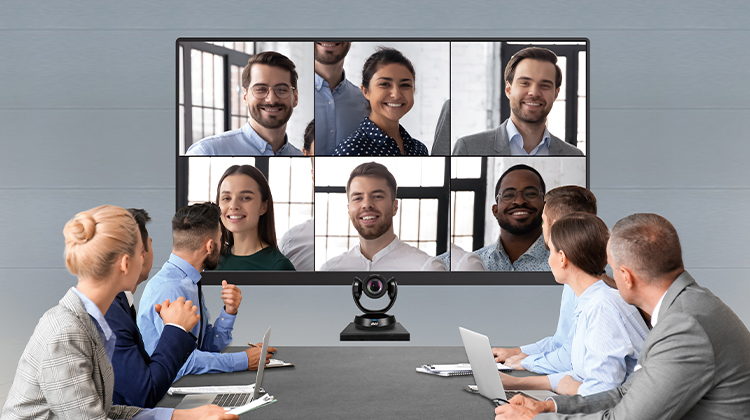Ever feel like the more meetings you attend the less work gets done by everyone? You're not alone. In today's hybrid workplace whether it's in a large meeting room or on virtual conference calls huddle time can take a toll on productivity. What’s more is that technical problems can often derail good efforts to make progress in these environments. Yet thankfully there’s a large amount of technical solutions and AI tools that can help get your meeting back on track.
What is the Collaboration Paradox?
Behavioral experts coined the term collaboration paradox to describe increased efforts to collaborate that can actually result in decreased productivity. Unsurprisingly a simple Google search yields endless statistics about time wasted in unproductive meetings.
Several factors contribute to the collaboration paradox:
- Information overload: With more people involved there's more information to share and process which can lead to confusion and decision paralysis.
- Communication challenges: Communication difficulties can arise when people are geographically dispersed or have different communication styles.
- Coordination problems: Coordinating the work of multiple people is difficult especially when they have different deadlines and priorities.
- Social loafing: This is the tendency for individuals to exert less effort when in a group compared to when working alone. When others are present it’s easy for everyone to assume someone else will take the lead.
- Tool overload: There are plenty of collaboration tools available but using too many can hinder collaboration by creating confusion and fragmentation.
Mastering Successful Collaborations

Overcoming the collaboration paradox starts with preparation before the meeting is convened.
- Set clear goals and expectations. Make sure everyone knows what they are supposed to do and how their work fits into the bigger picture. Collaboration works best when teammates leverage their unique strengths. Skills replication leads to internal competition and diminished individual ownership. Collaborative work requires everyone to be leaders in their field of expertise. Think: rock band not karaoke night!
- Establish clear communication channels. Teams should have clear guidelines for how to communicate with each other such as which channels to use for different types of communication. Not everything should be done at a meeting (e.g. email for non-urgent updates instant messaging for quick questions).
- Think alone, share together. Do your homework. Meetings are for building on ideas not generating them. Throwing around concepts in a group can be fun but the real legwork often happens before the meeting in the solo brainstorming stage. When we come prepared with independent thoughts we can evaluate ideas more effectively instead of scrambling to form them from scratch in the heat of the moment.
Technical Issues Can Hinder Collaboration Efforts
Collaboration is not just about navigating the realm of interpersonal skills. Hybrid meeting environments require technology to make everything go smoothly and if something is off technically then all that effort at working cohesively goes out the door. Here are some common technical snafus to watch out for during your next virtual meeting:
- Unstable Internet Connection - Dropped calls and lagging video are frequent problems that often affect the meeting quality. Each user’s bandwidth along with the total number of participants can really have an impact on the meeting.
- Audio Quality Problems - It’s bad when someone forgets they’re on mute but other issues like poor quality microphones and speakers or overpowering background noises can really upend the meeting experience.
- Video Quality Challenges - Common video quality issues are image pixelation, freezing screens, and asynchronous picture with sound. With these issues, it’s easy to get distracted by the poor quality of video and it’s often harder to make out colleagues’ facial expressions.
- Software Compatibility Issues - You’re ready to join a meeting only to find out your web browser is out of date and needs a new update. Software-related problems like this—or participants not using the same OS or a meeting notes app that isn’t compatible with the video conferencing software—can quickly halt a meeting in its tracks.
- Inadequate Security Measures - The largest problem by far with hybrid meetings are the host of cybersecurity dangers that can have widespread consequences. Unauthorized access and data breaches can not just upend a meeting but can cause much more damage to the whole company.
Overcoming Technical Challenges
Yet it’s important to remember that collaboration does not need to take a back seat to technical issues. While technical problems may be a roadblock to a successful meeting it’s just as easy to get those issues back on track.
- Seamless Internet Connection - Having a wired connection instead of using WiFi will ensure a stable meeting connection. Moreover configuring your router settings to have a MAC address filter or connecting via a Virtual Private Network (VPN) can also create a stable environment. Having backup solutions in place for handling unexpected internet disruptions is also a key strategy.
- Ensuring Audio Quality - Investing in high quality microphones and speakers can improve your next meeting. Remember to check cross-compatibility for all platforms and applications that you use. Combination camera & speaker solutions can be installed based on your particular hybrid meeting space. Also do not overlook good room acoustics (less background noise and minimal echo) as it will make voices come through crystal clear.
- Maintaining Good Video - Before logging online it’s important to check your camera configuration settings in each application. Is the resolution and video format correct? Does the software support this camera? Room lighting will also be a factor with your video to ensure that all participants are lit clearly. Most importantly having the right camera for your setup will really go the distance.
- Software Compatibility - While most teleworking applications are cross-compatible these days do your research first before committing. Look at the virtual meeting tools and other software you’ll be using to make sure that everything is copasetic.
- Improving Meeting Security - No one wants their next meeting to be zoom-bombed or compromised. Ensuring your video conferencing applications use end-to-end encryption and that participants sign in using multi-factor authentication (MFA) can avoid awful outcomes. Following the recent NSA security guidelines and making sure all applications are up-to-date will make your next meeting truly safe and secure.
AI Video Conferencing Tools Help with Housekeeping Tasks

Tasks meant to facilitate collaboration and effective communication can often become obstacles. For example sending meeting notes and action items can be tedious and time-consuming and often get neglected or forgotten. Lack of clarity on decisions made at a meeting and missing information leave teams in limbo.
A recent survey by Zoom found that over half of employees want regular summaries and action items but only 39% receive them. This creates a paradoxical situation where the time and effort invested in collaborating can obstruct progress.
AI can help overcome these challenges by automating tasks enhancing engagement and personalizing the meeting experience. Respondents in the same survey who use AI tools at work see significant time savings with 74% of leaders and 46% of employees saying it saves them at least an hour a day.
Some of the key ways AI is transforming video conferencing include:
- Noise cancellation and speech enhancement: AI can filter out background noise and enhance the clarity of speakers' voices ensuring everyone can be heard clearly. AI acoustics is embedded in many of AVer's video bars while scalable speakerphones ensure audio clarity that hits all the right notes and make every call feel like a face-to-face conversation.
- Audio tracking: AI-tracking cameras can utilize audio to automatically track the speaker and adjust the zoom to keep them in focus.
- Automatic framing: A smart dual-lens camera can track movement and keep everyone in the frame automatically adjusting for newcomers in real-time.
- Human detection: Say goodbye to blurry faces and awkward angles with AVer’s Smart Gallery which precisely detects faces and bodies dynamically cropping participants and ensuring everyone's looking their best in the spotlight. Meanwhile other AI functions can swiftly capture high-quality closeup images of meeting participants.
- Automatic transcription and closed captioning: AI can transcribe spoken words in real-time making meetings more accessible for people with hearing impairments and those who prefer to follow along visually. This can also be helpful for language learners or anyone who wants to quickly review what was discussed.
- Meeting summarization and action items: AI can analyze the content of a meeting and automatically generate a summary of key points and action items. This saves time and helps to ensure everyone is on the same page after the meeting.
- Virtual assistants: AI-powered virtual assistants can fast-track tasks like scheduling meetings formulating meeting agendas and analyzing individual communication preferences to provide personalized recommendations such as suggesting breaking up a long meeting into shorter sessions or recommending interactive activities to keep participants engaged.
The Key to a Hassle-Free Virtual Meeting
Using all these tools at your disposal will help you in your quest for a trouble-free and harmonious collaboration. While you may be subject to the pitfalls of technical woes like unstable internet connection poor audio/video software incompatibility or cybersecurity weakness the key is to take proactive measures to prevent these technical challenges from happening in the first place. AVer has a whole host of solutions that can help you achieve future collaborations.
The Upshot
Moving beyond the exhausting cycle of unproductive meetings requires preparation and shared ownership to make collaboration more effective. We can do this by understanding the collaboration paradox getting ahead of technical issues and taking advantage of AI tools many of which work behind the scenes in conferencing software to help us focus our work and promote clear communication.
For more information on how AVer can help you create a successful hybrid workplace, please see our Video Conferencing Solutions.
References